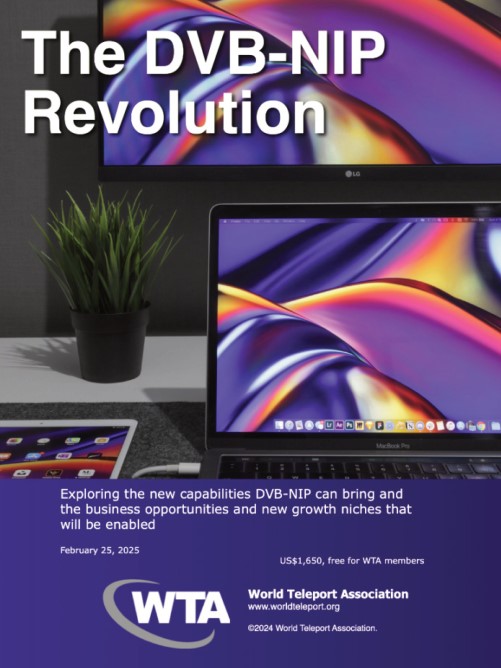Video via Satellite is Dead. Long Live Video via Satellite!
By Robert Bell
New York City, NY, April 2, 2025 - We all know the story. The days when broadcast TV is delivered by satellite are numbered. Pay-TV households in the US declined 31 percent, from 84 million in 2019 to 58 million by the end of 2023, according to Statista. While the decline was offset by growth in the Asia-Pacific and EMEA, Ampere Analysis predicts that this situation will change, as the industry experiences the first-ever annual decline in global pay TV penetration.
 |
But, as author Mark Twain wrote in 1897 after reading his own obituary – mistakenly printed by a newspaper – “Reports of my death are greatly exaggerated.” The same may be true of satellite video delivery, thanks to the 2024 introduction of DVB Native IP or DVB-NIP, a new standard for native IP broadcasting.
DVB-NIP integrates over-the-top OTT and broadcast paths into a single IP media distribution solution, which creates a platform capable of natively streaming incoming video to all devices on a home or business network. Just as vital, it enables the creation of services of high value to broadcasters, including ad insertion and content regionalization. Proponents and early adopters see this integration as a way to revolutionize satellite broadcasting, because it combines file-based and IP-based content delivery to to set top boxes, smart TVS, tablets and other connected devices.
What You Need to Know
DVP-NIP is an innovative response by DVB to massive changes in the broadcast business. If video is or could be part of your business strategy, WTA’s new report, The DVP-NIP Revolution, explores the new capabilities it brings and the business opportunities and new growth niches it can enable. Here are the highlights:
Broadcasting is well into a massive shift from satellite to internet delivery. The majority of video traffic is now delivered via IP – streaming services, corporate media, social media and e-learning. DVB-NIP will help satellite services blend seamlessly with other IP networks and is a necessity to help the satellite broadcast sector remain a viable player in the market as well as help solve challenges being created by the ever-growing amount of video content delivered to smart devices via the internet.
The technology is already proven. There has been positive feedback regarding DVB-NIP development efforts. Demonstrations at trade shows and a major deployment project with the government of Peru have shown that DVB-NIP is ready to be deployed and make an impact for satellite broadcasters.
Companies are ready to roll out the solutions. Companies that contributed to the development of the DVB standard are ready to offer solutions to broadcasters. Many consider rollout of the technology and the needed equipment to be a simple process. They are just waiting for customer demand.
"...DVB-NIP puts satellite in a better position. The world is consuming more video outside of traditional TV streams, and the development of DVB-NIP is a recognition that the satellite broadcast sector needs an IP-delivery solution. Satellite remains the most efficient manner to deliver content at scale...with the quality and efficiency of broadcast delivery...."
The business cases are still being developed. Service providers trust the DVB-NIP standard and see its potential, but many are hesitant to move forward without a strong business justification. With end-user customers seeking more and more short-term contracts – one or two years – to maximize their own flexibility, some service providers are not sure that the investments needed to offer DVB-NIP services will provide the needed returns.
DVB-NIP puts satellite in a better position. The world is consuming more video outside of traditional TV streams, and the development of DVB-NIP is a recognition that the satellite broadcast sector needs an IP-delivery solution. Satellite remains the most efficient manner to deliver content at scale, and DVB-NIP brings the advantages of modern IP-based clients together with the quality and efficiency of broadcast delivery. With DVB-NIP, satellite will be able to work with IP networks and compete when the opportunity arises.
With the Native IP standard, DVB has laid the foundation for introducing next-generation broadcasting services. It will save operators on platform costs for reaching IP devices in homes. In emerging markets, operators can serve mobile users via hotspot gateways in public spaces. Native IP will require operators to commit to additional transmission infrastructure and manufacturers to develop new home equipment. But DVB-NIP can definitely bridge the gap between OTT and traditional broadcast services – a gap in which the satellite industry once saw only a future of decline.
---------------------------
 Robert Bell is a strategic advisor to the World Teleport Association (WTA) www.worldteleport.org, which conducts research into the teleport and satellite industry, provides a unified voice for teleport operators and offers Teleport Certification programs to service providers. The DVB-NIP Revolution is available for for free to members and for sale to non-members from WTA’s online store.
Robert Bell is a strategic advisor to the World Teleport Association (WTA) www.worldteleport.org, which conducts research into the teleport and satellite industry, provides a unified voice for teleport operators and offers Teleport Certification programs to service providers. The DVB-NIP Revolution is available for for free to members and for sale to non-members from WTA’s online store.





